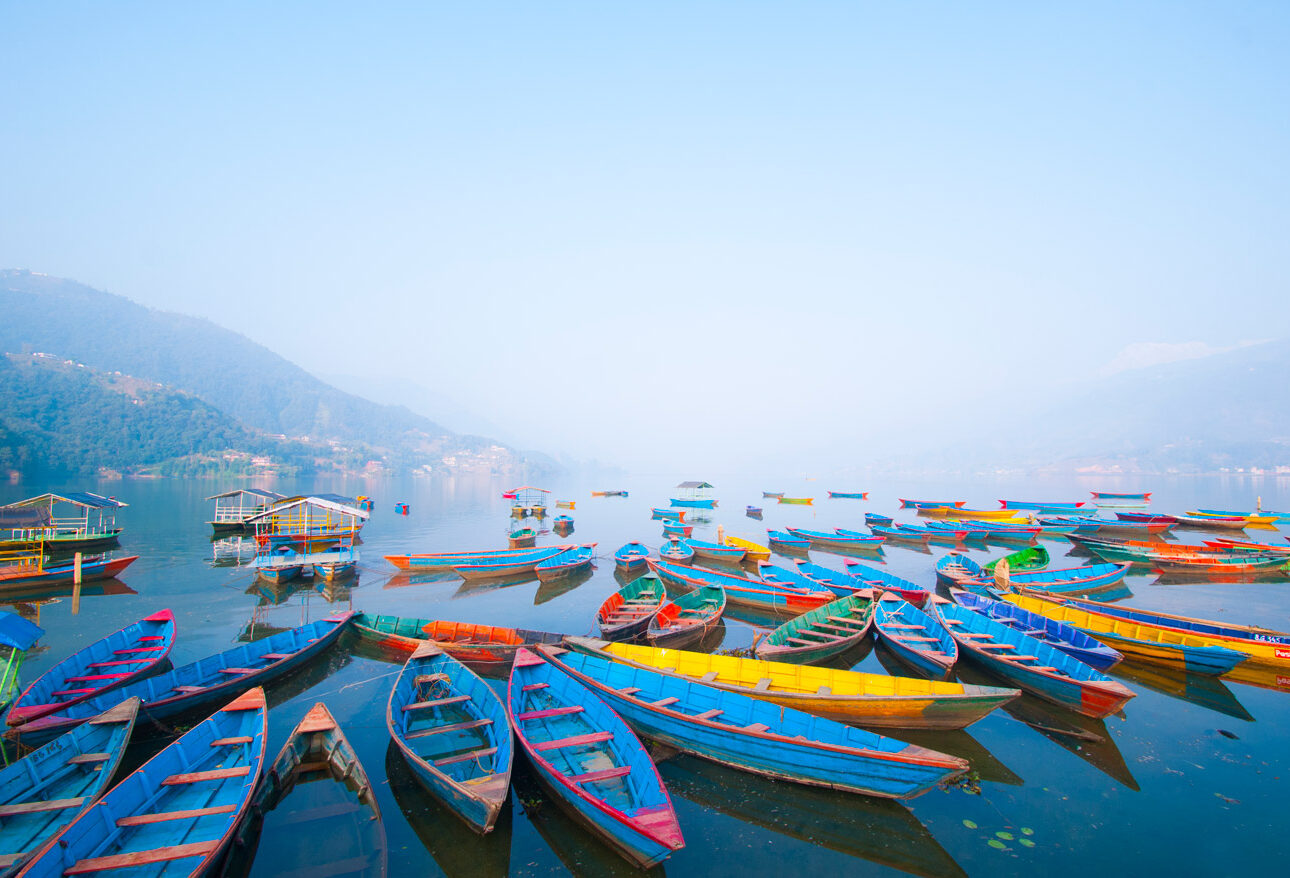Fewa Lake (Phewa Lake) also called Phewa Tal (In Nepali: फेवा ताल), is a stunning freshwater body located in the Pokhara Valley near Pokhara and Sarangkot in Nepal. This freshwater lake is river-fed, but a barrier balances the water flow; therefore, the lake is categorized as a semi-natural one.
The astonishing Himalayas is about 28 km far from the lake. The lake is also admired for the reflection of these epic mountains and peaks of the Annapurna and Dhaulagiri on its mirroring surface. At the heart of the lake lies a small island that The Tal Barahi Temple is built on.
Legends say that a goddess dressed herself up as a beggar and started wandering around the Himalayan Valley, but the people of the valley derided her. This point resulted in the flood that happened as revenge. The flood destroyed valleys and villages and drowned those who misbehaved with her. This divine punishment formed Lake Phewa, one of Nepal’s largest lakes.
An examination of Lake Dregs declares its formation date to be circa 13000 BC, while the nearby Pokhara city was formed later in the medieval era. As the region was on the old trading route between China and India, locals used to see foreigners wandering around since early times. But with the growth of tourism, modern amenities increased in the area, causing Pokhara to lose its small-town allure.
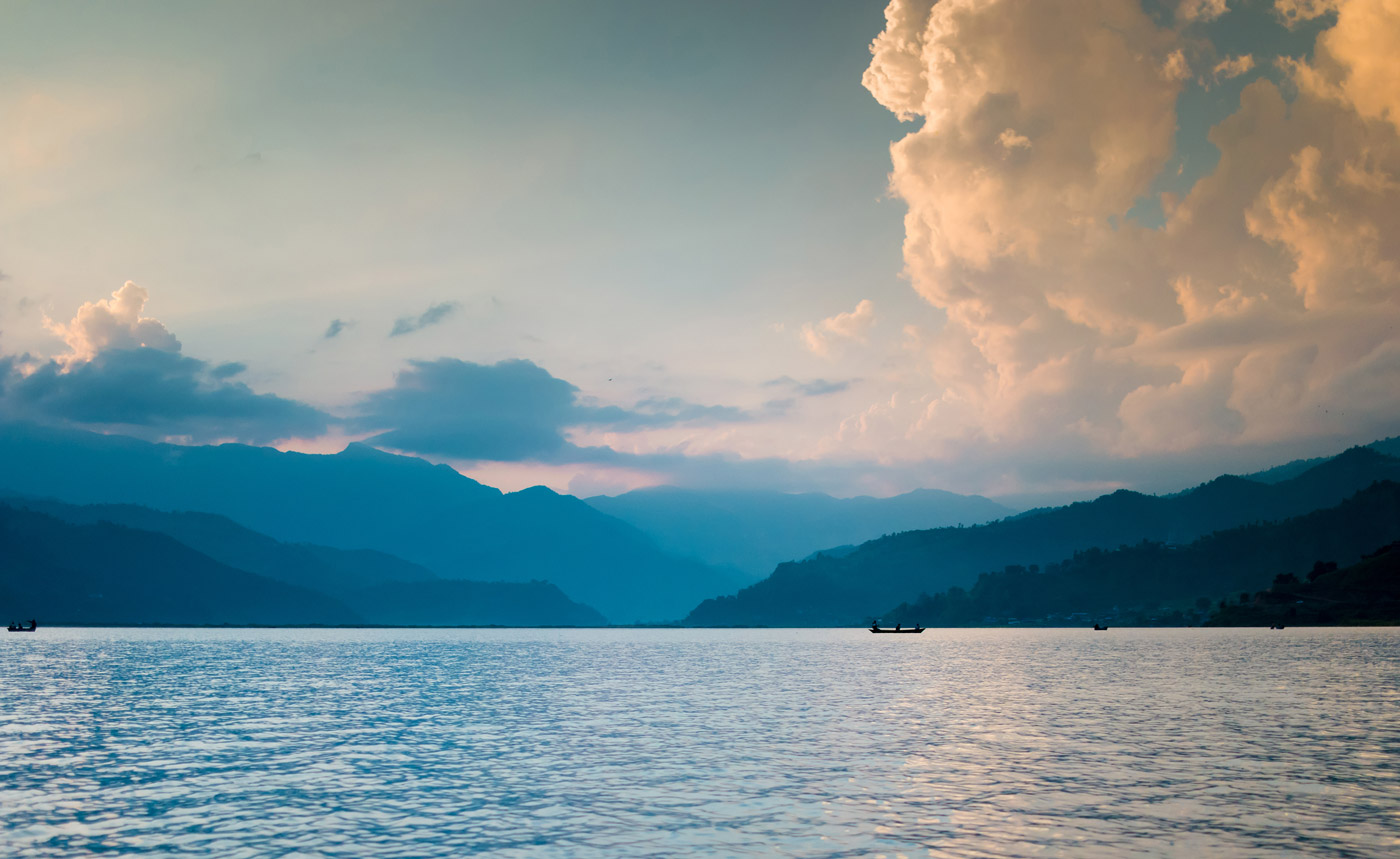
You can enjoy activities like paragliding, water sports, and usual yoga, Reiki, and massages on the lakeside road, but it is not a genuine aspect of the region. If you attempt to think out of the box of tourist areas, you will discover mind-blowing scenery and welcoming people to have memorable experiences. Remember to be respectful toward viewpoints and lifestyles different from yours and try embracing them.
Seasonal Weather Variations
The climate around Phewa Lake, like much of Nepal, is predominantly influenced by the monsoon cycle, presenting distinct seasons that each offer a unique experience of the region.
The peak tourist season, which offers the best weather for visiting Phewa Lake, is during the autumn months from September to November. During this period, the weather is typically dry and clear with moderate temperatures, providing excellent conditions for sightseeing and outdoor activities. The visibility is at its best, offering unfettered views of the Annapurna range reflected in the lake’s calm waters.
Winter, from December to February, presents cooler weather with the possibility of foggy mornings that can obscure mountain views. However, the afternoons are often sunny and pleasant, and the lake has a tranquil charm, with fewer tourists around.
Spring, which spans from March to May, is another favorable time to visit. The temperatures are comfortably warm, and the countryside is vibrant with blooming flowers, including the rhododendron, Nepal’s national flower. However, as the pre-monsoon season progresses, occasional rain showers and thunderstorms can occur.
The monsoon season, from June to August, is the least ideal time to visit Phewa Lake. Heavy rainfall can lead to muddy trails, and increased insects, and leeches in the surrounding forest areas. The humidity is high, and the persistent clouds often hide the mountains, though the rains do bring a lush, green landscape to life.

Festivals and Events
Phewa Lake’s region is culturally rich, and various festivals occur throughout the year, adding to the allure of a visit.
One of the most significant events is the Phewa New Year Festival in mid-April, coinciding with the Nepali New Year. This event is marked by vibrant boat races on the lake, live music, and cultural performances, showcasing the local traditions and community spirit.
Another notable festival is the Teej Festival in late August or early September, where women dress in beautiful red sarees and celebrate with singing, dancing, and fasting, in honor of the Hindu goddess Parvati and marital bliss.
Dashain, usually in October, is the longest and most auspicious festival in the Nepalese annual calendar, celebrated by Hindus throughout the country. During Dashain, you can witness kite flying, traditional swings (ping), and various ritual celebrations around the lake.
Tihar, the festival of lights, follows Dashain in late October or early November. Homes and businesses around the lake are adorned with candles, lamps, and colorful decorations, creating a mesmerizing spectacle at night.
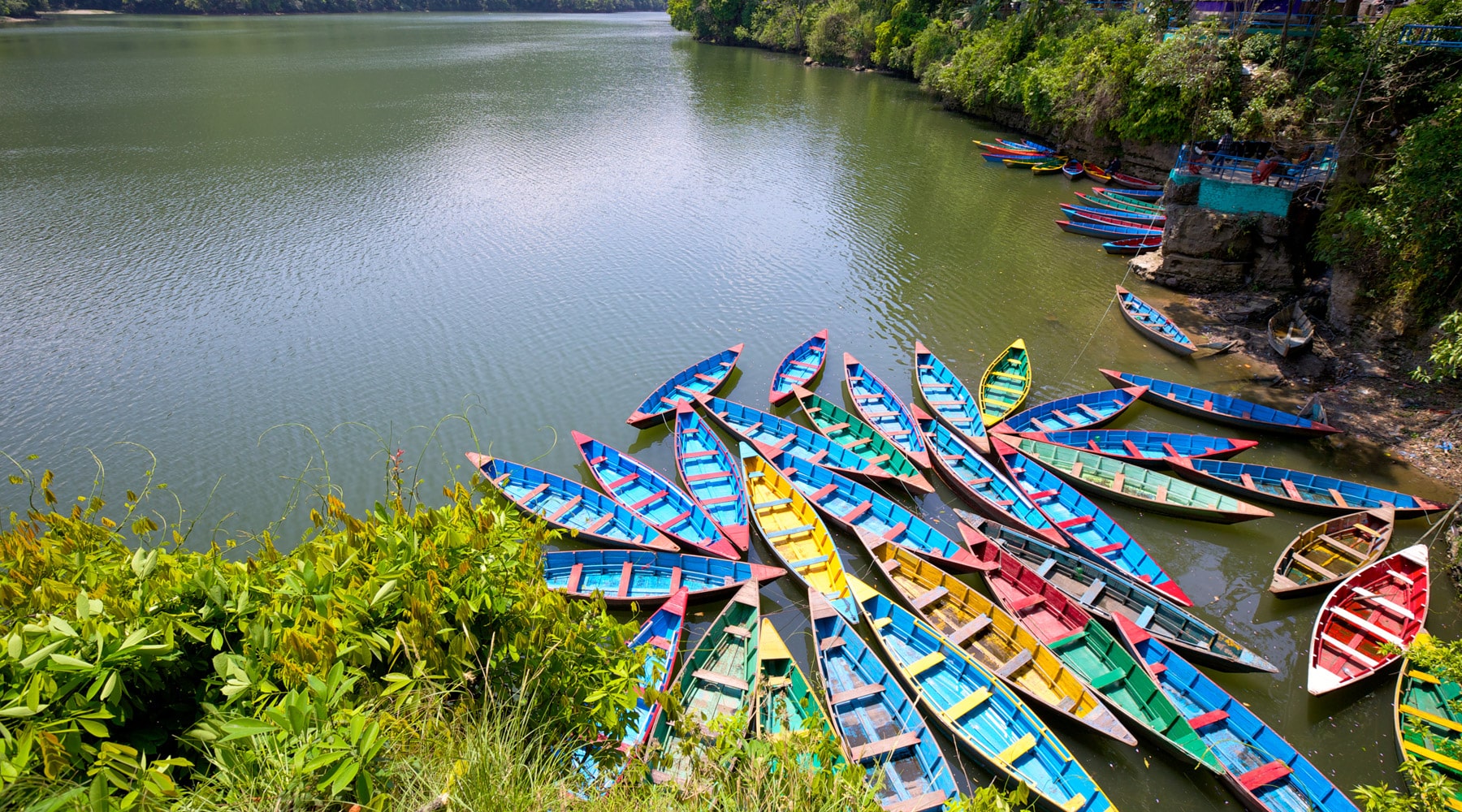
Visitors should note that while these festivals provide unique cultural experiences, they can also affect transportation, accommodation availability, and the opening hours of local businesses. It’s advisable to book well in advance if planning to visit during these peak cultural events.
Planning the Trip
The region has a subtropical and sultry climate; however, the snowy heights of the Himalayas also affect the weather. Although summers are not too hot and winters too cold, it is mostly recommended to schedule your trip for spring or fall, especially October, to enjoy mild weather. Anyway, you might like taking your personal preferences and avoiding tourist peaks into consideration.
Getting to Pokhara
While you can get to Pokhara by bus both from Kathmandu, the border town of Sunauli, and Butwal, you can only take a flight there from Kathmandu. The road offers amusing views of peaks and a rural Nepalese lifestyle worth overcoming a few difficulties in the ride. But it is safer to travel by plane during the rainy season due to slippery roads. Getting to the region by plane offers the advantage of a bird’s eye view of the whole area, especially the panoramic mountains of the Himalayas.
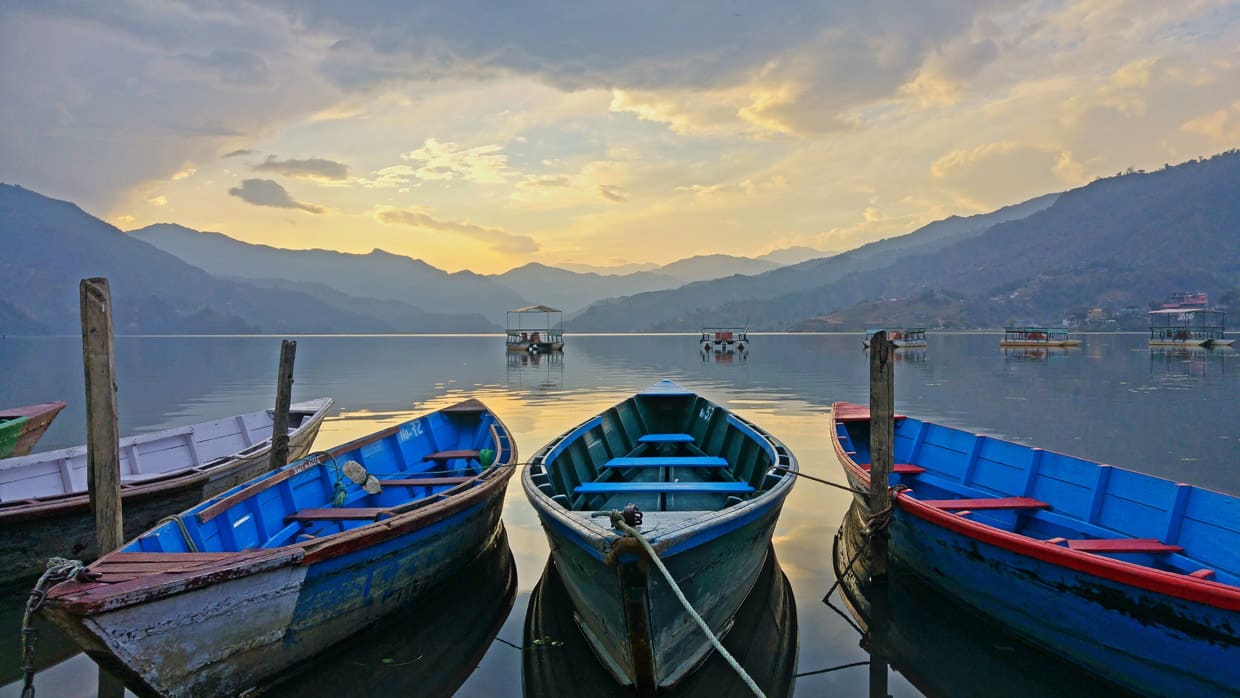
Getting to the Fewa Lake
There are various ways to get to Phewa Lake from Pokhara. If you want to refresh your lungs with fresh air, you might like the idea of walking there or riding a rental bicycle, motorcycle, or scooter. You can also utilize buses and taxis to get to the lake. Buses are economical and therefore usually crowded, while taxis offer more private and comfortable space.
Fewa Lake’s surroundings unfurl as a verdant panorama, alive with dynamic communities set against the Annapurna Mountain range’s majestic silhouette to the north. The lake itself acts as a mirror, reflecting the lofty peaks of Machhapuchhre (Fishtail) and its mountainous brethren, creating breathtaking imagery on its placid surface.
The Lakeside area on the eastern shore is a colorful mosaic of welcoming cafes, bustling shops, and intimate hotels, offering visitors a perfect blend of leisure and adventure. It’s a cultural melting pot where you can indulge in the rich flavors of Newari cuisine or discover unique handcrafted treasures. In contrast, the western and southern shores present a tranquility found in the shadow of forest-clad hills, amid traditional hamlets and terraced fields that paint a picture of Nepal’s pastoral charm.
Phewa Lake is also the heart of recreational bliss. Whether gliding in a boat, slicing through the water in a kayak, or paragliding from Sarangkot’s heights, there’s a peacefulness that touches the soul. The sacred Tal Barahi Temple, perched on its island, adds a spiritual dimension to the lake’s allure and is conveniently reached by a brief boat journey.

The lake’s biodiversity is a delicate tapestry of life, encompassing a myriad of flora and fauna vital to the Pokhara Valley’s ecosystem. Water lilies and lotus blooms grace the lake’s surface, while a diverse range of fish beneath supports the traditional fishing community. Bird enthusiasts will find joy in observing kingfishers, herons, and kites, making it a serene haven for birdwatching. Meanwhile, the surrounding woodlands echo with avian song.
Yet, Phewa Lake’s ecological balance is under threat from pollution, siltation, and invasive species, prompting concerted conservation efforts. Sustainable tourism initiatives are key to preserving this ecological treasure for posterity, allowing future generations to experience its natural and cultural magnificence.
Viewpoints
The grandeur of Phewa Lake and its environs is magnified from above. Several vantage points offer breathtaking vistas, accessible by hiking, cycling, or driving. The World Peace Pagoda (Shanti Stupa) and Sarangkot are famed for their panoramic views. Nearby hills like Kahun Dharahara and Dhiki Danda also offer stunning perspectives, with the former reachable by bus, car, or motorbike, and the latter a hiker’s delight.
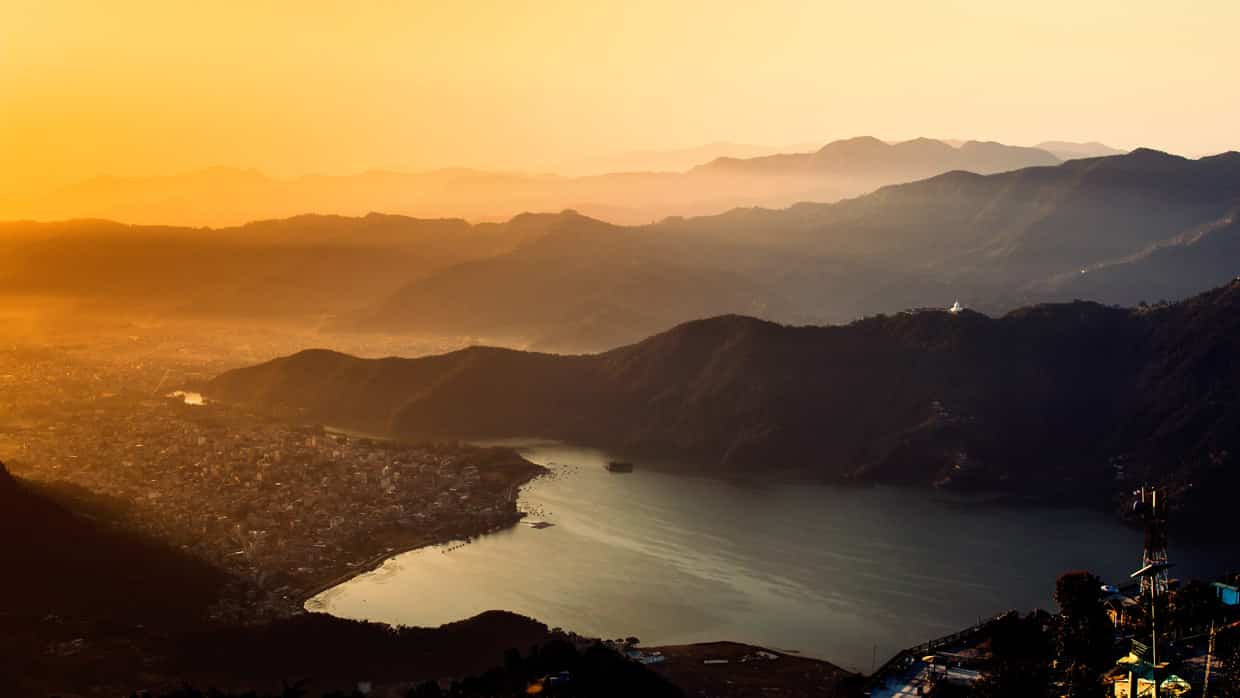
Lakes and Waterfalls
Begnas Lake (Begnas Tal) invites tranquility, with nearby hostels and a Vipassana Meditation Retreat enhancing the serene experience. The journey to Begnas Tal is a picturesque walk through the ebb and flow of local life. Rupa Lake (Rupa Tal), in its seclusion, offers peace and untouched natural beauty, ideal for those seeking solace in the wilderness. Dipang Lake (Dipang Tal) showcases nature’s artwork with wild lotuses and swans adorning its surface. After the rains, Devi’s Falls (Patale Chhango) becomes a dramatic spectacle, plunging into a subterranean cave.
Caves
The region’s caves beckon the adventurous. Mahendra Cave (Mahendra Gufa) is renowned for its limestone formations, while the proximity of Chamare Cave (Chamare Gufa) offers a glimpse into the world of cave bats. Within Mahendra Cave, a likeness of the god Shiva presides, and similarly, Gupteshwor Mahadev Cave, not far from the cascading Devi’s Falls, is home to a revered Shiva lingam stalagmite. These natural sanctuaries provide a profound experience and can be explored in tandem for a day’s adventure.
You might start your exploration in Baidam, located on the eastern banks of Phewa Lake, mostly known as lakeside. There are numerous stripes of hotels, guesthouses, restaurants, and souvenir shops on this road.
You can wander around this road visiting restaurants, cafes, and bars or taking a rest booking a room in a hotel or a hostel if you are not planning to camp. Live music and music festivals are popular around. Merchants offer handmade items like Jewels and trinkets as souvenirs of the area.
You can also find centers around providing paraglides and boats. There are also some modern spas for yoga, massage, meditation, and Reiki, providing over a dozen various retreats. Some also arrange 1-20 day treks, including hiking as well as courses in yoga and meditation.
Lakeside can lead you to start exploring the shores of Phewa Lake on foot or by riding a bicycle. In contrast to the garish tourism growth of the lakeside, the precipitous southwestern lakeside is covered with a velvety forest and alive with birds singing.
The vigorous Rani Ban, or Queen’s Forest, puts an emerald shade on the lake combined with the reflection of snow-white peaks of Annapurna mountains on its mirror surface on clear days.
You can boat on the lake with one of the Doongas (boats) painted in vivid colors that are available for rent at the lakeside. The lake seems enchanting in the sunrises and sunsets when you are swinging in the boat. The glassy water of the lake makes it possible to observe the life of fabulous fish. You can boat toward the southeast side of the lake, where Tal Barahi Temple is located on a small island.
Tal Barahi Temple, also known as the Lake Temple, is located at the center of Phewa Lake. This temple is one of the most important religious monuments of Nepal for Hindus. This two-storied pagoda was dedicated to Vishnu, a Hindu god.
As a devotee of Goddess Durga and the first Shah king of Kaski, King Kulmandhan Shah built the temple on the island at the heart of Lake Phewa. Prayers usually visit this temple on Saturdays.

